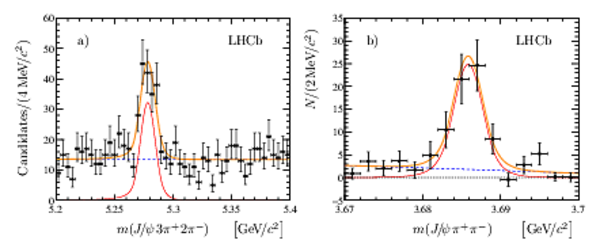Observation of $B^+\rightarrow J/\psi 3\pi^+ 2\pi^-$ and $B^+\rightarrow \psi(2S) \pi^+\pi^+\pi^-$ decays
[to restricted-access page]Information
LHCb-PAPER-2016-040
CERN-EP-2016-247
arXiv:1610.01383 [PDF]
(Submitted on 05 Oct 2016)
Eur. Phys. J. C77 (2017) 72
Inspire 1489630
Tools
Abstract
The decays $B^+\rightarrow J/\psi 3\pi^+ 2\pi^-$ and $B^+\rightarrow \psi(2S) \pi^+\pi^+\pi^-$ are observed for the first time using a data sample corresponding to an integrated luminosity of $3.0fb^{-1}$, collected by the LHCb experiment in proton-proton collisions at the centre-of-mass energies of 7 and 8 TeV. The branching fractions relative to that of $B^+ \rightarrow \psi(2S)K^+$ are measured to be \begin{eqnarray*} \frac {\mathcal{B}\left(B^+\rightarrow J/\psi 3\pi^+ 2\pi^- \right)} {\mathcal{B}\left(B^+ \rightarrow \psi(2S)K^+ \right)} & = & \left(1.88\pm0.17\pm0.09\right)\times10^{-2}, \frac {\mathcal{B}\left(B^+\rightarrow \psi(2S) \pi^+\pi^+\pi^- \right)} {\mathcal{B}\left(B^+ \rightarrow \psi(2S)K^+ \right)} & = & \left(3.04\pm0.50\pm0.26\right)\times10^{-2}, \end{eqnarray*} where the first uncertainties are statistical and the second are systematic.
Figures and captions
|
(a) Mass distributions of the selected $ B ^+ \rightarrow { J \mskip -3mu/\mskip -2mu\psi \mskip 2mu} 3\pi ^+ 2\pi ^- $ candidates. (b) Sum of mass distributions for all backgrounddash-subtracted $ { J \mskip -3mu/\mskip -2mu\psi \mskip 2mu} \pi ^+ \pi ^- $ combinations. The total fit function is shown with thick solid (orange) lines and the signal contribution with thin solid (red) lines. The dashed (blue) lines represent the combinatorial background and nondash-resonance component for plots (a) and (b), respectively. |
Fig_1.pdf [75 KiB] HiDef png [208 KiB] Thumbnail [187 KiB] *.C file tex code |

|
|
Mass distributions (a) of the selected $ B ^+ \rightarrow \psi {(2\mathrm{S})} K ^+ $ candidates and (b) backgrounddash-subtracted $ { J \mskip -3mu/\mskip -2mu\psi \mskip 2mu} \pi ^+ \pi ^- $ combination. The total fit function is shown with thick solid (orange) lines and the signal contribution with thin solid (red) lines. The dashed (blue) lines represent the combinatorial background and nondash-resonance component for plots (a) and (b), respectively. |
Fig_2.pdf [76 KiB] HiDef png [197 KiB] Thumbnail [156 KiB] *.C file tex code |

|
|
(a) Mass distribution of the selected $ B ^+ \rightarrow { J \mskip -3mu/\mskip -2mu\psi \mskip 2mu} 3\pi ^+ 2\pi ^- $ candidates with the additional requirement of every $ { J \mskip -3mu/\mskip -2mu\psi \mskip 2mu} \pi ^+ \pi ^- $ combination to be outside of $\pm6 {\mathrm{ Me V /}c^2} $ around the known $\psi {(2\mathrm{S})}$ mass. The total fit function, the $ B ^+$ signal contribution and the combinatorial background are shown with thick solid (orange), thin solid (red) and dashed (blue) lines, respectively. (b) Sum of mass distributions for all possible backgrounddash-subtracted $\pi ^+ \pi ^- $ combinations. The factorisationdash-based model prediction is shown by a solid (red) line, and the expectation from the phasedash-space model is shown by a dashed (blue) line. The total fit function, shown with a dotted (green) line, is an incoherent sum of a relativistic Breitdash-Wigner function with the mean and natural width fixed to the known $\rho ^{0}$ values and a phasedash-space function multiplied by a seconddash-order polynomial. |
Fig_3.pdf [77 KiB] HiDef png [224 KiB] Thumbnail [202 KiB] *.C file tex code |

|
|
Distributions of (a) $\pi ^- \pi ^- $, (b) $\pi ^+ \pi ^+ $, (c) $\pi ^+ \pi ^+ \pi ^- $, (d) $\pi ^+ \pi ^- \pi ^- $, (e) $\pi ^+ \pi ^+ \pi ^+ $, (f) $2\pi ^+ 2\pi ^- $, (g) $3\pi ^+ \pi ^- $ and (h) $3\pi ^+ 2\pi ^- $ masses in the $ B ^+ \rightarrow { J \mskip -3mu/\mskip -2mu\psi \mskip 2mu} 3\pi ^+ 2\pi ^- $ decay. The prediction from the factorisationdash-based model is shown by solid (red) lines, and the expectation from the phasedash-space model is shown by dashed (blue) lines. |
Fig_4.pdf [166 KiB] HiDef png [550 KiB] Thumbnail [518 KiB] *.C file tex code |

|
|
Distributions of (a) $\pi ^+ \pi ^- $, (b) $\pi ^+ \pi ^+ $ and (c) $\pi ^+ \pi ^+ \pi ^- $ masses in the $ B ^+ \rightarrow \psi {(2\mathrm{S})} \pi ^+ \pi ^+ \pi ^- $ decay. The predictions from the factorisationdash-based model is shown by solid (red) lines, and the expectation from the phasedash-space model is shown by dashed (blue) lines. |
Fig_5.pdf [90 KiB] HiDef png [244 KiB] Thumbnail [221 KiB] *.C file tex code |

|
|
Animated gif made out of all figures. |
PAPER-2016-040.gif Thumbnail |

|
Tables and captions
|
Signal yields, $N$, of $ B ^+ $ decay channels. Uncertainties are statistical only. |
Table_1.pdf [43 KiB] HiDef png [43 KiB] Thumbnail [20 KiB] tex code |

|
|
The $\chi^2$ per degree of freedom for the factorisationdash-based and phasedash-space models for the multipion system in nondash-resonant $ B ^+ \rightarrow { J \mskip -3mu/\mskip -2mu\psi \mskip 2mu} 3\pi ^+ 2\pi ^- $ decays. |
Table_2.pdf [36 KiB] HiDef png [43 KiB] Thumbnail [21 KiB] tex code |

|
|
The $\chi^2$ per degree of freedom for the factorisationdash-based and phasedash-space models for the multipion system recoiling against $\psi {(2\mathrm{S})} $ in $ B ^+ \rightarrow \psi {(2\mathrm{S})} \pi ^+ \pi ^+ \pi ^- $ decays. |
Table_3.pdf [36 KiB] HiDef png [24 KiB] Thumbnail [11 KiB] tex code |

|
|
Relative systematic uncertainties (in %) for the ratios of branching fractions. The total uncertainty is the quadratic sum of the individual components. |
Table_4.pdf [55 KiB] HiDef png [54 KiB] Thumbnail [24 KiB] tex code |

|
Created on 27 April 2024.
